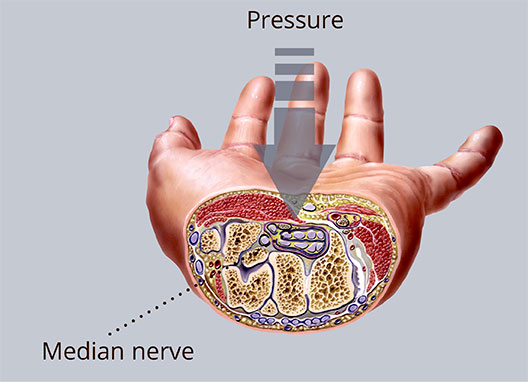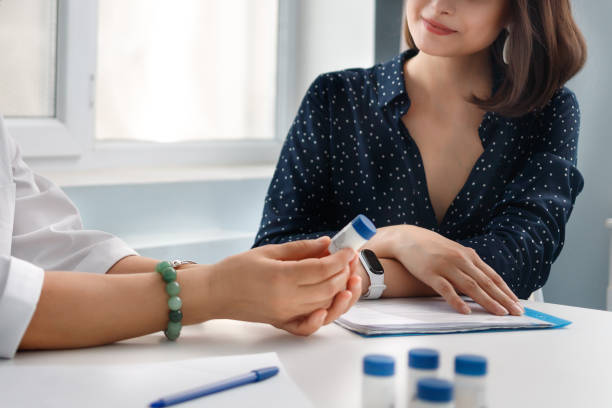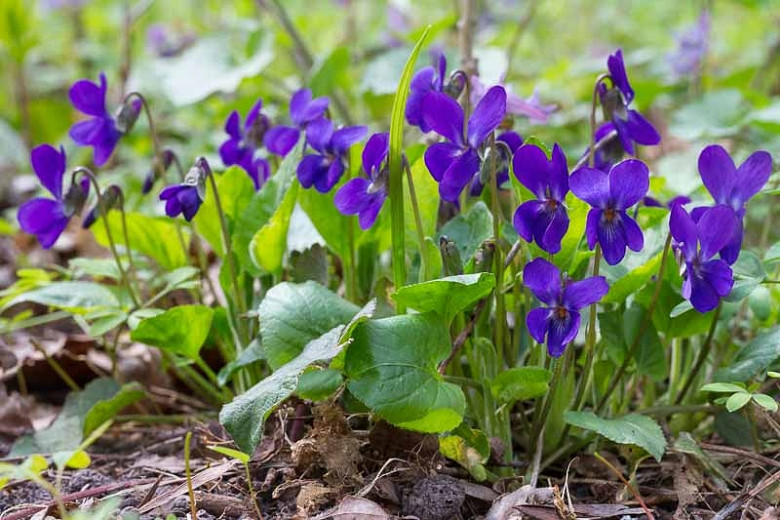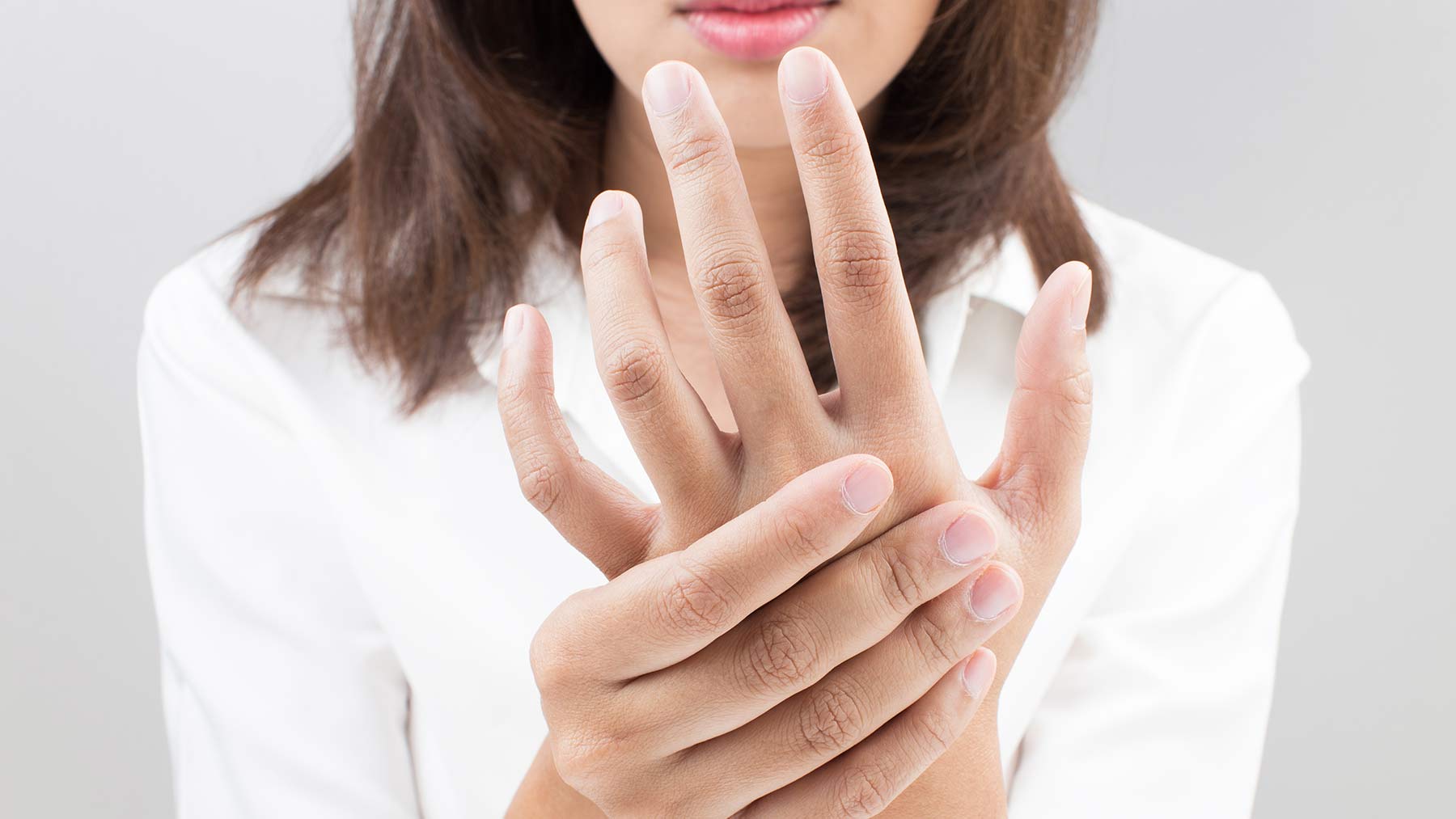Carpal Tunnel Syndrome is the disease/irritation of median nerve locating in the area inside of the wrist (wrist contains bones, ligaments, and the median nerve). This nerve is responsible for controlling sensation and facilitating movement of the thumb and the first three fingers (close to the thumb). If the median nerve is compressed or pinched, it leads to carpal tunnel syndrome symptoms including pain, tingling, numbness, and weakness in the hand.
Thank you for reading this post, don't forget to subscribe!Symptoms
Patients with carpal tunnel syndrome initially feel numbness and tingling of the hand in the distribution of the median nerve (the thumb, index, middle, and thumb side of the ring fingers). These sensations are often more pronounced at night and can awaken people from sleep. The reason symptoms are worse at night may be related to the flexed wrist sleeping position and/or fluid accumulating around the wrist and hand while lying flat. Patient may feel the need to shake out his/her hands and wrists. Tasks like driving, reading a book, or talking on the phone may bring on symptoms. Patient’s hands may feel weak and it might be hard to grasp small objects. Moving the hand may make symptoms less prominent.
Occasionally, sharp shooting pains can be felt in the forearm. Carpal tunnel syndrome may increase one’s sensitivity to temperature in the affected hand, and/or wasting (atrophy) of the hand muscles, particularly those near the base of the thumb in the palm.
Symptoms of carpal tunnel syndrome include pain, weakness, numbness, and tingling of the hand, wrist, and fingers. Carpal tunnel syndrome may be a temporary condition that completely resolves or it can persist and progress.
Differentiate from…
Pain, numbness, tingling, weakness, and muscle atrophy can be due to symptoms other than carpal tunnel syndrome. These include:
- Thumb or wrist arthritis
- Diabetic neuropathy or other nerve issues
- Ligament, muscle, or tendon injury
What are the three stages of carpal tunnel?
Carpus is derived from the Greek word karpos, which means “wrist.” The wrist is surrounded by a band of fibrous tissue that usually supports the joint. The tight space between this fibrous band and the wrist bone is called the carpal tunnel. The median nerve passes through the carpal tunnel to receive sensations from the thumb, index, and middle fingers of the hand leading to dropping things/objects. As the disease progresses, patients can develop a burning sensation, and/or cramping and weakness of the hand.
Any condition that causes swelling or a change in the position of the tissue within the carpal tunnel can squeeze and irritate the median nerve. Irritation of the median nerve in this manner causes tingling and numbness of the thumb, index, and middle fingers — a condition known as “carpal tunnel syndrome.”
The three stages of carpal tunnel syndrome include:
- Stage 1: An early stage of carpal tunnel syndrome that results in mild symptoms, such as occasional numbness, weakness, or tingling in the wrist or hand. These symptoms are usually more prominent at night and may be relieved by moving or shaking the wrist or hand.
- Stage 2: A moderate stage of carpal tunnel syndrome with symptoms that occur more frequently or persistently. Symptoms may include tingling, numbers, and weakness of the hand or wrist that can occur during the day, making it hard to perform daily tasks. Pain is usually present, as well as a loss of grip strength.
- Stage 3: A severe stage of carpal tunnel syndrome with constant symptoms that cause functional impairment. Symptoms may include significant weakness in the hand and muscle wasting. People typically have trouble performing simple tasks, such as turning a doorknob.
Not everyone with carpal tunnel syndrome will experience all the stages above, and the severity of their symptoms will vary widely.
What triggers carpal tunnel syndrome?
For most patients, the cause of their carpal tunnel syndrome is unknown. Any condition that exerts pressure on the median nerve at the wrist can cause carpal tunnel syndrome.
Common conditions that can lead to carpal tunnel syndrome include:
- Obesity
- Pregnancy
- Thyroid disorders (such as hypothyroidism)
- Arthritis (such as rheumatoid arthritis)
- Diabetes
- Trauma or injury.
Tendon inflammation resulting from repetitive work (repetitive stress injuries), such as uninterrupted typing, can also cause carpal tunnel symptoms.
Hormonal changes during menopause or pregnancy have been shown to increase one’s risk of developing carpal tunnel syndrome.
Some rare diseases can cause the deposition of abnormal substances in and around the carpal tunnel, leading to nerve irritation. These diseases include:
- Amyloidosis
- Sarcoidosis
- Multiple myeloma
- Leukemia
Beyond that, some people may have a genetic predisposition to developing carpal tunnel syndrome. This may include certain anatomical features including a smaller carpal tunnel or a protruding wrist bone.
Diagnosis
There’s no one carpal tunnel syndrome test. The diagnosis of carpal tunnel syndrome is suspected based on the symptoms and the distribution of hand numbness. With the Tinel test, the doctor will tap on the median nerve to see if it triggers tingling in the fingers. The Phalen test, patient hold the back of his/her hands together for 60 seconds to see if the activity produces numbness and tingling. Examination of the neck, shoulder, elbow, pulses, and reflexes can be performed to exclude other conditions that can mimic carpal tunnel syndrome. The wrist can be examined for swelling, warmth, tenderness, deformity, and discoloration.
Sometimes tapping the front of the wrist can reproduce tingling of the hand and is referred to as Tinel’s sign of carpal tunnel syndrome. Symptoms can also at times be reproduced by the examiner by bending the wrist downward (referred to as Phalen’s maneuver).
The diagnosis is strongly suggested when a nerve conduction velocity test is abnormal. This test involves measuring the rate of speed of electrical impulses as they travel down a nerve. In carpal tunnel syndrome, the impulse slows as it crosses through the carpal tunnel. A test of muscles of the extremity, electromyogram (EMG), is sometimes performed with the nerve conduction velocity test to exclude or detect other conditions that might mimic carpal tunnel syndrome.
Blood tests may be performed to identify medical conditions associated with carpal tunnel syndrome. These tests include thyroid hormone levels, complete blood counts, and blood sugar and protein analysis. X-ray tests of the wrist and hand might also be helpful to identify abnormalities of the bones and joints of the wrist.
Allopathic Treatment for carpal tunnel syndrome
The choice of allopathic treatment for carpal tunnel syndrome depends on the severity of the symptoms and any underlying disease that might be causing the symptoms.
Initial treatment of carpal tunnel syndrome usually includes the following:
- Rest
- Immobilization of the wrist in a splint
- Occasional ice application
Those whose occupations are aggravating the symptoms should modify their activities. For example, computer keyboards and chair height may need to be adjusted to optimize comfort. These measures, as well as periodic resting and range of motion stretching exercises of the wrists, can prevent the symptoms of carpal tunnel syndrome that are caused by repetitive overuse. Underlying conditions or diseases are treated individually.
Fractures can require orthopedic management. Obese individuals will be advised regarding weight reduction. Rheumatoid disease is treated with measures directed against underlying arthritis.
Wrist swelling that can be associated with pregnancy resolves in time after the delivery.
Allopathic medications for the treatment of carpal tunnel syndrome are:
- Vitamin B6 (pyridoxine) has been reported to relieve some symptoms of carpal tunnel syndrome.
- Nonsteroidal anti-inflammatory drugs can also help decrease inflammation and reduce pain for the time being. Side effects of NSAIDs include gastrointestinal upset and even ulceration of the stomach. These medications should be taken with food, and abdominal symptoms should be reported to the doctor immediately.
- Corticosteroids can be given by mouth or injected directly into the involved wrist joint. They can bring rapid but temporary relief to the persistent symptoms of carpal tunnel syndrome. Side effects of these medications, are very deep acting and long lasting; and should be avoided in the presence of any infection.
Occasionally, chronic pressure on the median nerve can result in persistent numbness and weakness. To avoid serious and permanent nerve and muscle consequences of carpal tunnel syndrome, that’s why allopathic doctors advise surgical procedure.
Surgery involves severing the band of tissue around the wrist to reduce pressure on the median nerve. This surgical procedure is called “carpal tunnel release.” It can now be performed by microsurgery with a small diameter viewing tube, called an arthroscope, or by open wrist procedure. After carpal tunnel release, patients often undergo exercise rehabilitation. Though surgery has less good results, almost 96% patients remains with the pain and symptoms for lifetime.
Surgery for Carpal Tunnel Syndrome
Surgery typically done on an outpatient basis under local anesthesia. For the surgery, the doctor makes an incision up to 2 inches long along the wrist and cuts a ligament inside the wrist to relieve pressure on the median nerve. Endoscopic surgery is also a possibility to treat carpal tunnel syndrome via small incisions in the wrist.
Sometimes the procedure is done endoscopically, (using a tiny camera inserted through a very small incision to guide the procedure).
There are many strong evidence that alternative therapy (Homeopathy) has very good results in treating carpal tunnel syndrome.
Complications
Complications of carpal tunnel syndrome especially after surgery, include atrophy and weakness of the muscles at the base of the thumb in the palm. This can be a permanent complication and can lead to a lack of dexterity in the affected fingers and residual weakness can occur..
Homeopathic Treatment for Carpal Tunnel Syndrome
In homeopathy a doctor consider the symptoms of carpal tunnel syndrome in context of the whole person, and chosen the medicines to match the way the person experiences their carpal tunnel syndrome symptoms, their state of health and personal circumstances.
Here are very few medicine for carpal tunnel syndrome:
Rhus toxicodendron
Rheumatic stiffness of nape and neck, with painful tension. Painful swelling of axillary glands. Rheumatic tearing between scapulae, Tearing between shoulders. Bruised pain in sacrum. Distortion of the vertebral column. Tearing and burning sensation in shoulder, with paralysis of arm. Coldness, paralysis, and insensibility of arm, weak; rheumatic paralysis. Exostosis in arm with burning and itching in arms, hands, and fingers. Tension in elbow-joint. Jerking tearing in elbows, wrists, and joints of fingers. Digging in bones of the forearm. Weakness and rigidity of forearm and fingers during movement, and trembling of those parts after the least exertion. Tearing in all the finger-joints.-Warts on hands and fingers.
Ruta graveolens
Spine and limbs feel bruised. Small of back and loins pain. Legs give out on rising from a chair, hips and thighs so weak. Contraction of fingers. Pain and stiffness in wrists and hands. Ganglia. Sciatica; worse, lying down at night; pain from back down hips and thighs. Hamstrings feel shortened. Tendons sore. Aching pain in tendo-Achilles.
Phosphorus
Rigidity of nape of neck.-Pressure on shoulders.-Swelling of neck.-Engorgement of axillary glands and of those of nape of neck and of neck.-Itching and shooting under axillae. Paralysed sensation in hand. Rheumatic tearing (and lancinating pains) in shoulders, arms, and hands (particularly in joints). Burning pain in palms of hands and arms; clammy perspiration in palms and on head. Numbness of arms and hands.-Lassitude and trembling in arms and hands. Wrenching pain in joints of hands and fingers, with tension.
Acid Benzoicum
Stiffness of neck (one sided). Nape: pressure; itching. Dull pain in back; stiffness in loins. Coldness in sacrum. Nodes on joints of upper and lower extremities, cracking on motion. Gouty concretions. Syphilitic rheumatism. Gouty deposits in both wrists between metacarpal bones; swelling of elbow-joints. Paralytic pains of fingers. Eruption of red spots on fingers. Fingers swollen, tearing and fine stitching pains in various parts of the limbs. Ganglion. Panaritium.
Graphitus
Stiffness in the nape of the neck.-Violent pain in the nape of the neck and the shoulders, on stooping the head, and on raising the arms, like a tearing incision. Swelling of the glands of the neck.-Tearing in the glands of the neck. Contractive pain in between the shoulders. Sensation of tingling in the back. Formication in the back. Tearing and lancinating in the shoulders. Sensation of contraction in the joint of the elbow, on extending the arms. Cramp and tearing in the hands. Feel swelling and inflexibility, stiffness and distortion of the fingers. Granulated eruption and corrosive vesicles on the fingers.-Arthritic nodosities on the fingers.-Tettery excoriation between the fingers.-Thickness of the nails of the fingers.
Viola odorata
Tension in muscles of the neck.-Jerking drawing in cervical muscles, near nape, extending down. Rheumatism of one side; motion of the affected side almost impossible. Bruised pain in all bones in morning in bed, after waking, disappears after rising. Relaxation of all the muscles. Drawing pains in limbs. Pain as if broken in all joints. Trembling of limbs. Slight trembling of arms; dyspnoea. Rheumatism of upper limbs; deltoid (especially of right carpal and metacarpal joints). Drawing pain in elbow-joint and back of hand. Pressive, aching pain in the wrists, especially right side.
Arnica Montana
Weakness of the muscles of the neck; the head falls backwards. Painful swelling of the neck glands. Pains, as from a bruise, and of dislocation. Tingling in the back. Great soreness of the back. Dragging-down pain and sense of weight in loins. Pain, as if from fatigue, and crawlings in the arms and in the hands, as of dislocation, in the joints of the arms and hands. Tingling, in the arms. Sensation of soreness of the arms. Sensation as if the joints of the arms and wrists were sprained. Darting in the arm. Veins in the hands swollen, with full and strong pulse. Want of strength in the hands on grasping anything.-Cramps in the fingers.
Calcarea phosphorica
Rheumatic pain and stiffness of neck with dullness of head. Cramp-like pain in neck first one side then the other. Throbbing or jerking pains below scapula. Violent pain in region of back when making the least effort. Backache and uterine pains. Sharp pains in sacrum and coccyx. Soreness as if separate in sacroiliac synchondrosis. Curvature of the spine to the left; lumbar vertebrae bend to the left; spina bifida.
Rheumatic pains in shoulder and arm, also with swelling of the diseased part and febrile heat. Ulcerative pain especially in roots of finger nails (especially right hand); and in middle finger. Gouty nodosities. Soreness, torpor, and paralysis of the arm. Paralysis of the joints of the hand and of the fingers, especially in the thumbs, sometimes from a chill.
Kali Carbonicum
Stiffness between scapulae.-Dull pain, like hot water, between scapulae.-Stiffness of nape of neck. Weakness of muscles of neck. Burning, tearing near right side of spine, above small of back. Sharp stitching pains. Swelling of shoulder, with pain. Swelling and sore pain of axillary glands. Cracking in shoulder-joint. Pain under right shoulder-joint, sensitive to moving and touching. Tearing, tension and pulling in muscles and joints of shoulders, arms, hands, and fingers. Cold stiffness and numbness of arms. Frequent startings in arms. Stiffness in joint of elbow. Paralytic pain in wrist. Shootings in wrist and fingers during movement. Trembling of hands when writing. Coldness of hands. Torpor and numbness of fingers. Burning pain in fingers. Gnawing vesicles on fingers. Startings in fingers when sewing. Tearing between thumb and index finger.
Kali Phosphoricum
Stiff neck from swelling of glands. Neck lame, tender to touch. Aching between scapulae. Severe stiches in middle of back; towards front of chest with dyspnoea. Creeping sensation and intense pain along spine relieving the headache at intervals. Back lame as from a fall; sore from shoulders down. Aching in shoulders and arms. Severe pain in scapulae. Pain first in scapula.Soreness and swelling of axillary and parotid glands. Pain in arms from raising them. Twitching of muscles of arms and fingers. Numbness of arm and hand; itching and purple. No feeling in fingertips.
Acid Phosphoricum
Tension and cramp-like drawing in muscles of neck. Boils under axillae. Boring pain between scapula. Spondylitis of cervical vertebrae. Painful to touch – back, shoulder-blades, neck, and chest.-Burning pain in a spot. Itching stitch in coccyx; fine stitches in coccyx and sternum. Crawling (formication) tingling in Hands. Boring, digging, drawing pain in shoulder-joint, intermittent. Cramp-like pressure in arms, hands, and fingers. Drawings and jerking tearings in arms and fingers.-Eruption of pimples on arms.-Drawing, incisive pains in joints of elbows, hands, and fingers.-Sharp, shooting, boring pains under l. forearm near elbow, < at rest.-Numbness in course of r. radial nerve.-Weakness and trembling of arms.-Trembling of hands (when writing).-Ganglion on back of hand.-Skin of hands and fingers dry, shrivelled, parched.-Fingers dead, sometimes on one side only, and within well-defined limits.-Lancinations (stitches) in fingers and joints of fingers.
Magnesia Phosphorica
Pain in forearm from elbow to hand, or from wrist to knuckles. Darting pain in arms. Skin of fingers feels as if stretched too tightly; followed by pain in elbow-joint and in wrist. Throbbing pain in wrist near ulna. Shoulder-joint lame. Rheumatic, aching pain in shoulder, radiating to arm; increases with heat, feels better with motion; coming on when retiring, disturbing sleep; lasts all night, disappearing in morning after moving about.. Tingling in fingers. Stinging pain in first joint of the thumb, extending to next, like that of a panaritium. First joint of fingers of both hands swollen, though painless.
Lachesis
Lameness and pain in shoulder-joint with headache. Perspiration in axillae of strong smell (like garlic). Rheumatic and arthritic pains, and aching pains in bones of arms, in hands, fingers, and wrists. Malignant ulcer on upper part of arm. Tension, as from contraction of tendons, from the elbow to fingers. Erysipelatous inflammation in elbow. Sensation of fatigue or of paralysis, and pain, as from dislocation, in arms. Paralysis of hands. Trembling of hands. The hands are dry and burning with numbness, tingling, prickling and pain. Itching, psoric eruptions, red spots with vesicles, furunculi, excrescences, and warts on hands and fingers. Hard and cold swelling of a bluish black colour, on the back of hand and fingers. The hands are cold. Hard swelling from hand to elbow, with excessive pain and panaris.
Ignatia Amara
Lancinating, cutting pain in the shoulder-joint. Insupportable pains in the bones and joints of the arms, as if the flesh were being loosened. Paralytic sensation and pain as dislocation. Convulsive startings in the arms (in the deltoid muscle) and in the fingers. Tearing in the arms excited by cold air and cold compressions. Hot sweat of the hands. Sensation of torpor and digging in the arms, at night/in bed (with the sensation as if something living were running in the arm).
Staphysigaria
Aching of shoulders. Stitches in shoulder joints, better on touch and motion. Stiffness of shoulder-joint in morning. Shoulders sore to lie on, and stiff-neck. Pressive, paralytic, burning, drawing, and lancinating tearings, in arms (feels better on motion and touch), and forearms, shoulders, hands, and fingers. Painful pressure in arm bone. Paralytic drawing in metacarpal joints, feels better from motion. Hands become anaemic from cardiac inertia; gouty pains in little finger, index and thumb at night, and loss of power in thumb. Numbness in ends of fingers. Jerking tearing in fingers and/or fingertips. Arthritic nodosities in finger joints. Osteitis of phalanges of fingers.
Drosera
Twitchings in shoulder, only when at rest. Pains, as from a bruise, in the joints of the arms and of the hands. Cramp and stiffening of the fingers, on grasping an object. Nocturnal pains in the bones of the arm, going off during motion in the day.
Aconitum Napellus
Pain, as from a bruise, and weakness in the arms and shoulders, with swelling. Heaviness in the arms, with numbness in the fingers. Numbness of the arm. Paralytic weakness of the arm and hand, especially in writing. A sensation of drawing in the arms. Hands numbed/dead. Swelling of the hands. Heat in the hands with cold in the feet. Cool sweat on the palms of the hands. Icy coldness of the hands. Tingling in the fingers, particularly when writing. Inflammatory swelling of the elbow, with numbness, and a paralytic state of the fingers.
Salix Mollissima
Sciatic neuritis in nervous hands, in whom the capillary cutaneous circulation showed up visibly. Tenderness, numbness, pain and swelling of the hands, or wrist.
Zincum Metallicum
Tearing in limbs, feels better when overheated or when taking exercise. Drawing tearing in hollow bones, with pain so violent that the limbs can give no support. Stiffness of joints, with sharp, lancinating pains above joints, always transverse, not lengthwise of the limb. Coldness of extremities. Drawing, tearing pains in all limbs. Violent itching in wrist, in all joints. Spasmodic pain and cramp in the limbs. Visible quivering and jerking in different parts of the muscles. Tingling.
Agaricus Muscarious
Arms weak and without vigour. Burning pain in the arms, followed by an eruption of small pimples with scaling of the epidermis. Irregular and hurried movements of arm (). Upper arms shaken as from an electric shock. Prostration, weariness, and paralytic feeling in arm. Tearing in both hands. Trembling of hands; and coldness. Cramp-like pain in the thumb. Paleness and numbness of the fingers, which are, at the same time, very sensitive to cold. Itching, burning pain, and redness in the fingers, as if from chilblains.
Crotalus Horridus
Bruised pains in bone of shoulder in paroxysms. Tight, cord-like feeling extending from front elbow down front of forearm, with “round spots” of pain here and there along front of forearm. Tubercle on wrist, near end of radius, size of large split-pea, and rather blue from sting of insect some years before, more pronounced in summer months. Vesicular and pustular eruption about wrists. Trembling of hands.-Hands go dead on least exertion. Violent spasmodic pains in palm (like bee-sting). Itching and heat of palms. Oozing of blood from under nails.
Conium Maculatum
Shoulders painful, as if they had been bruised and excoriated. Humid, scabby, and burning tetters in the forearms. Numbness of the hands, and palms. Cracking in the wrist-joint. Sweat in the palms of the hands. Torpor of the fingers. Itching in the back of the fingers. Yellow spots on the fingers and yellowish nails. Panaris.
Medorrhinum
Rheumatic pain in top of shoulder, feels better from motion; occasional little darts of pain if kept still. Rheumatic pain in shoulder and arm. Brown, itching eruption on shoulder. Cold numbness outer side of arms just below elbow. Cracking of joints, especially elbows. Much pain in arm even cannot hold a paper; veins become enlarged (poor circulation). Trembling of arms and hands. Burning of hands. Small yellow spots on hands. Transverse depression on nails, as if they were bent. Consumptive incurvation of nails.
Causticum
Sciatica. Pain with numbness. Paralysis of single parts. Dull, tearing pain in hands and arms. Heaviness and weakness. Tearing joints. Unsteadiness of muscles of forearm and hand. Numbness; loss of sensation in hands. Contracted tendons. Weak ankles. Cannot walk without suffering. Rheumatic tearing in limbs; better by warmth, especially heat of bed. Burning in joints. Restless at night. Cracking and tension and stiffness in joints.
Guaiacum
Weakness in the arms. Tearing and shooting in the shoulder-blades, and in the forearms. Sharp stitches in shoulder. Rheumatic pains in arm from shoulder to wrist. Lancinating rheumatic pains from elbow to wrist. Rheumatic pains in wrist-joint. Stitches in thumb.
Hypericum
Stitches on the top of the shoulder at every inspiration. Flying pains in shoulder. Neuralgia and paralytic pain in upper arm. Tension and numbness in both arms and in the hands.
Bellis Perennis
Pain inner side forearm, as if a boil developing. Pain in middle finger of hand, as of a gathering; for a short time only. Joints sore, muscular soreness. Itching on back and flexor surfaces. Wrist feels contracted. Sprains.
Plumbum Metallicum
Convulsive movements of arms and hands, with pain in joints. Drawing and tearing in arms and fingers. Wrist-drop. Weakness and painful paralysis of arms and hands. Dilatation of veins on back of hands, arms, and calves. Ganglion on back of hands. Wens on hands. Difficulty in moving fingers. Red and swollen spots on fingers.
Magnetia Muriaticum
Drawing and paralytic tearings in shoulder-joint, extending as far as arm and hand, feels better by movement. Numbness of arms in morning, on waking; or in evening in bed.
Saccharum lactis
Swelling in arm below elbow, sore to touch, and pains when she moves arms in certain directions. Pain from top of shoulder to nape of neck. Pain from shoulder passing down to waist, breast. Pain in axillae. Sharp pain in all fingers except little finger. Pain in both hands passing to ends of fingers. Pain in dorsal surface, in palm. Violent itching of a liver spot on hand. Pains in hands passing in all directions – into thumb, finger to elbow, from wrist to elbow. Stiffness in wrists.
Arnica Montana
Pain, as if from fatigue, and crawlings in the arms and in the hands. Pain, as of dislocation, in the joints of the arms and hands. Tingling in the arms. Sensation of soreness of the arms. Sensation as if the joints of the arms and wrists were sprained. Darting in the arm. Veins in the hands swollen, with full and strong pulse. Want of strength in the hands on grasping anything. Cramps in the fingers.
Moringa Oriflora
Moringa has many important vitamins and minerals. The leaves have about as much potassium as a banana, and about the same amount of vitamin C as an orange. It also has calcium, protein, iron, and amino acids, which help your body heal and build muscle.
It’s also packed with antioxidants, substances that can protect cells from damage and may boost your immune system. There’s some evidence that some of these antioxidants can also lower blood pressure and reduce fat in the blood and body. Rheumatoid arthritis: Moringa leaf extract lowers fluid swelling, redness, and pain (inflammation).
Today’s my prescription was instead of allopathic multivitamins advised Moringa Oriflora-Q OD/TDs said Dr Qaisar Ahmed.
P. S : This article is only for doctors having good knowledge about Homeopathy and allopathy, for learning purpose(s).
For proper consultation and treatment, please visit our clinic.
Location, address and contact numbers are given below.
NoN of above mentioned medicine(s) is/are the full/complete treatment, but just hints for treatment; every patient has his/her own constitutional medicine.
To order medicine by courier, please send your details at WhatsApp– +923119884588
 Dr. Sayyad Qaisar Ahmed (MD {Ukraine}, DHMS), Abdominal Surgeries, Oncological surgeries, Gastroenterologist, Specialist Homeopathic Medicines.
Dr. Sayyad Qaisar Ahmed (MD {Ukraine}, DHMS), Abdominal Surgeries, Oncological surgeries, Gastroenterologist, Specialist Homeopathic Medicines.
Senior research officer at Dnepropetrovsk state medical academy Ukraine.
Location: Al-Haytham clinic, Umer Farooq Chowk Risalpur Sadder (0923631023, 03119884588), K.P.K, Pakistan.
Find more about Dr Sayed Qaisar Ahmed at :
https://www.youtube.com/Dr Qaisar Ahmed
https://www.facebook.com/dr.qaisar.dixecosmetics

Comments are closed.